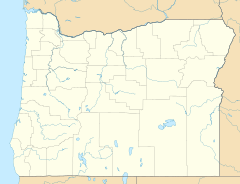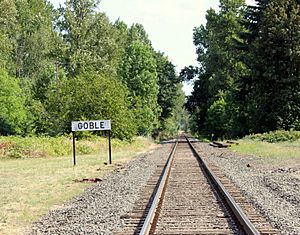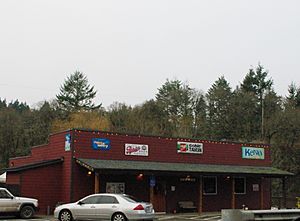Goble, Oregon facts for kids
Quick facts for kids
Goble, Oregon
|
|
|---|---|
| Country | United States |
| State | Oregon |
| County | Columbia |
| Time zone | UTC-8 (Pacific (PST)) |
| • Summer (DST) | UTC-7 (PDT) |
| ZIP code |
97048
|
| Area code(s) | 503 and 971 |
Goble is a small, unincorporated community in Columbia County, Oregon, United States. It is located right along U.S. Route 30 and the famous Columbia River. This area has a rich history, especially because of its connection to early transportation and exploration.
Contents
History of Goble
The area where Goble is located was likely a stopping point for the famous Lewis and Clark Expedition. They explored this region in the early 1800s.
Goble was first settled by Daniel B. Goble in 1853. Legend says he named the town after a turkey named "Goble" after a funny challenge!
For many years, Goble was a very important place. It was the Oregon end point for a special train ferry. This ferry carried entire trains across the Columbia River to Kalama, Washington. This was before any railroad bridges were built across the river in this area. Goble even had its own post office from 1894 to 1960.
Early Community Names
The history of this area can be a bit confusing. Over time, five or six different names were used for communities very close to each other. These names included Hunters, Reuben, Goble, Mooreville, Red Town, and Enterprise. All these names appeared around the same time.
The story really begins in 1870. That's when Kalama, Washington, was chosen as the starting point for a major railroad project. This was the Pacific Division of the Northern Pacific Railroad. By 1879, there was a landing on the Oregon side of the Columbia River. It was called Enterprise Landing.
When people tried to open a post office there in 1890, the name "Enterprise" was already taken. So, they chose the name "Reuben" instead. This post office was about a mile south of where Goble is today. Reuben was named after Reuben R. Foster, the brother of the first postmaster.
Railroad Connections
Regular train service from Tacoma to Kalama started on January 5, 1874. Trains connected with riverboats on the Columbia River. The Northern Pacific Railroad wanted to build a transcontinental line. This meant they needed a route from Portland to Kalama.
On September 8, 1883, the "Last Spike" was driven in Montana. This completed a big section of the Northern Pacific Railroad. A special train celebrating this event arrived in Tacoma on September 13, 1883. It had traveled over the Portland-Hunters line.
Hunters was the first site for the railroad ferry. A post office called "Hunters" opened there on May 29, 1888. Hunters was about two miles south of today's Goble. The Northern Pacific Railroad soon moved its ferry operations to a new spot at Goble. The Hunters post office closed in October 1893, and Goble was officially planned out in 1891.
Train Ferry History
Before a railroad bridge connected Portland, Oregon and Vancouver, Washington, Goble was home to a very important train ferry.
The Northern Pacific Railroad built tracks on the Oregon side of the Columbia River leading to Goble. In the 1880s, the company bought one of the largest ferries in the world. They shipped it all the way to Oregon.
To move this huge ferry, called The Tacoma, crews took it apart. It was broken down into 57,159 pieces! These pieces were then shipped around Cape Horn, which is at the very southern tip of South America. The ferry was put back together in Portland. From 1884 to 1908, The Tacoma carried trains across the Columbia River. It first operated from Hunters and later from Goble to Kalama, Washington.
Goble's Economy
In the 1890s, Goble was a busy "boomtown." This means it grew very quickly. Its economy was strong because of several things:
- Logging: Cutting down trees and processing wood was a major industry.
- Steamboats: Wood-fired steamboats on the Columbia River stopped in Goble to refuel.
- Trains: As many as six trains stopped in Goble every day on their way to Seattle.
Today, there are not many businesses left in Goble. However, the historic Goble Tavern is still open.
While the Trojan Nuclear Power Plant is often said to be in Rainier, it is actually closer to Goble and Prescott.
Points of Interest
Goble is known for some unique natural features:
- Goble Caves: These caves and other rock formations produce rare crystals.
- Unique Crystals: Two types of Zeolite crystals, called Tschernichite and Boggsite, were first discovered right here in Goble.
Deer Island is another interesting spot. It's an uninhabited island in the Columbia River. Lewis and Clark stopped there in 1805 and 1806 during their journey. The community of Deer Island is also nearby on the Oregon mainland.




